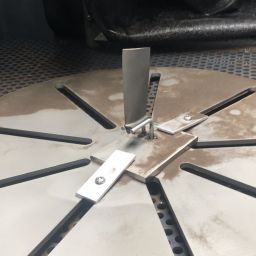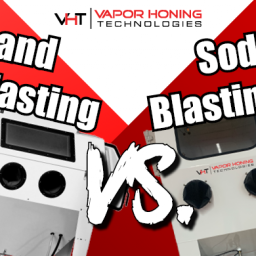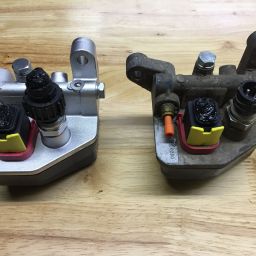
Safety & Abrasive Blasting
Abrasive blasting, whether wet or dry, is a powerful tool, but it’s not without risks. Proper safety protocols in combination with personal protective equipment (PPE) are crucial to prevent injury and protect your investment. The environment in which blasting occurs, open air, dry cabinet, or vapor blasting cabinet, determines what risks are present and what protection is necessary. As Ben Franklin once said, “an ounce of prevention is better than a pound of cure.” Without further ado, let’s start by looking at Open Air Blasting!
Open Air Blasting

Open-air abrasive blasting is often used on large industrial equipment, vehicles, or buildings. It exposes operators to the full force of flying abrasive, airborne dust, and ricocheting particles. Because there’s no containment, PPE must act as the sole line of defense.
Required PPE includes:
-
A NIOSH-approved respirator (Type CE supplied-air helmet for silica blasting)
-
Full abrasive-resistant suit or coveralls
-
Blast helmet with face shield
-
Heavy-duty gloves
-
Hearing protection
-
Steel-toe, slip-resistant boots
Notes:
In this setting, OSHA compliance is non-negotiable. Regular monitoring, proper containment systems, and air filtration plans are essential. When blasting with materials that exceed permissible exposure limits (PELs) it is a matter of user’s long-term health, perhaps even life, to be OSHA compliant. Materials like silica, lead, chromium, and cadmium have very low PELs, meaning even brief unprotected exposure can cross regulatory thresholds. All blasting methods can inflict noise damage on the user without proper gear. Open air blasting undoubtably has the biggest risks attached to the use of it. It is really only a method of surface finishing you would use if you had no other options.
Sealed Dry Blasting Cabinets

Dry blasting cabinets offer a much safer alternative to open-air blasting by sealing off the process inside a closed chamber. Operators use built-in gloves and view the part through a window, greatly reducing direct exposure to abrasive and dust.
Required PPE includes:
-
Safety glasses (as a backup in case of glove or seal failure)
-
Hearing protection while blasting
-
Slip-resistant footwear
-
Optional dust mask during media handling or maintenance
Notes:
Risks would include things like media leaks from worn seals or gloves. Dust accumulation during maintenance or loading/unloading. Compressed air or pressure failures… You see while this environment is significantly safer, proper training and machine maintenance are still critical. Cabinets must be regularly inspected for worn gaskets, cracked windows, or pressure issues to ensure containment remains effective. Thankfully with proper maintenance and observance a sealed sand blasting cabinet is nearly as safe as a wet blasting cabinet.
Best Practices for Prevention
-
Inspect gloves and gaskets before each use. Look for any cracks or other signs of wear in your rubber components. Places that come to mind first and foremost would be around the arm ports and the door seals.
-
Clean out old media and dust buildup weekly. Residual dust near vents or seals can compromise air quality over time.
-
Install a pressure gauge and automatic shutoff. These systems can detect abnormal spikes or drops in air pressure and prevent unexpected hose bursts or overloading. Fortunately, Vapor Honing Technolgies’ Dry Blast series come with these preinstalled for you!
-
Test the pressure relief valve monthly. A working relief valve ensures that your cabinet doesn’t build excess pressure in the event of a blockage.
-
Check hose fittings and connections. Even a partially loose hose can create pressure inconsistencies or spray media into sensitive components.
-
Log maintenance activity. Keep a record of inspections, filter changes, and any parts replacements so you have a timeline of service and a heads-up on when components are nearing the end of their lifespan. Being meticulous over these details may in fact be the most valuable preventative measure as it keeps maintenance on your mind.
Dust Collectors & Media Reclamation Systems
In sealed dry blasting cabinets, dust collectors and media reclamation systems help to maintain a safe, stable, and healthy work environment. These systems reduce airborne contaminants, ensure consistent blast quality, and minimize risks associated with buildup and equipment strain. Together they also extend the life of your equipment while in the process of aiding you cabinet in running smoothly.
Dust collectors are responsible for capturing the fine particles created during blasting. Without proper dust extraction, visibility inside the cabinet can decrease dramatically, increasing the likelihood of part mishandling or process errors. Worse, excess dust can collect around vents, filters, and moving parts, leading to overheating or pressure imbalances. For operators, even sealed environments can become hazardous when accessing the machine for loading, unloading, or maintenance if dust has not been properly contained. Dust collection systems help maintain negative pressure within the cabinet, reducing the risk of dust escape and supporting a clean, breathable workspace. They also prevent fire hazards caused by excessive accumulation of flammable dust in tight spaces—a risk often overlooked.
Media reclamation systems enhance safety in a different but equally critical way. These systems separate reusable media from broken-down particles, contaminants, or sharp debris that shouldn’t be cycled back through the blast stream. Consistently cleaned media means fewer nozzle clogs, more predictable air pressure, and a reduced risk of blasting defects that could damage both the part and the machine. Reclamation also minimizes the need for frequent media changes, reducing how often operators must open the machine and come into contact with residual dust or used abrasive. This not only reduces exposure but also limits manual handling and lowers the chance of spillage.









